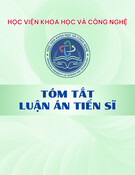
MINISTRY OF EDUCATION AND TRAINING
UNIVERSITY OF ECONOMICS HO CHI MINH CITY
--------------------------------
NGUYEN HUU KHOI
TIME PERSPECTIVE AND CONTINUANCE INTENTION
TO USE MOBILE COMMERCE:
THE DUAL ROLE OF PERCEIVED RISK AND SECURITY
Major: Business administration
Code: 9340101
SUMMARY OF DISSERTATION

Ho Chi Minh city – 2020
The research was conducted and completed at University of Economics Ho Chi Minh city:
Academic advisors :
Reviewer 1 :.........................................................................
.............................................................................................
Reviewer 2 :.........................................................................
.............................................................................................
Reviewer 3 :.........................................................................
.............................................................................................
The dissertation will be defended at University of Economics Ho Chi Minh city at hour day month
year
The dissertation can be found at the following library :…………….………………

LIST OF AUTHOR’S PUBLISHED PAPERS
Publications on International journals:
1. Nguyen Huu Khoi, Nguyen Dong Phong, Angelina Nhat-Hanh Le, (2019), Customer
inspiration in a tourism context: an investigation of driving and moderating factors, Current
Issues in Tourism, doi: https://doi.org/10.1080/13683500.2019.1666092.
2. Nguyen Huu Khoi, Ho Huy Tuu & Svein Ottar Olsen, (2018), The role of perceived values in
explaining Vietnamese consumers’ attitude, social norm and intention to adopt mobile
commerce, Asia Pacific Journal of Marketing and Logistics, Vol. 30 Issue 4, pp.1112-1134
3. Nguyen Huu Khoi & Angelina, Nhat-Hanh Le, (2018), The impact of social media on
consumer behavior: the case of consumer-generated content on YouTube, International
Journal of Information and Management Sciences, Vol. 29 Issue 3, 323-344
4. Nguyen Dong Phong, Nguyen Huu Khoi, Angelina Nhat-Hanh Le, (2018) "Factors affecting
mobile shopping: a Vietnamese perspective", Journal of Asian Business and Economic
Studies, Vol. 25 Issue 2, pp.186-205
Publications on Vietnamese national journals:
1. Nguy n H u Khôi. Vai trò c a l i ích, s đánh đi và giá tr đi v i ý đnh s d ng th ngễ ữ ủ ợ ự ổ ị ố ớ ị ử ụ ươ
m i di đng. T p chí Kinh t & Phát tri n, 269, 21-31.ạ ộ ạ ế ể
2. Nguy n H u Khôi. (2019). Tác đng c a đnh h ng th i gian, chi phí và l i ích c m nh nễ ữ ộ ủ ị ướ ờ ợ ả ậ
đn ý đnh s d ng th ng m i di đng c a ng i tiêu dùng t i Vi t Nam, 30(4), 65-80.ế ị ử ụ ươ ạ ộ ủ ườ ạ ệ
3. Nguy n H u Khôi. (2019). Giá tr c m nh n và ý đnh s d ng th ng m i di đng: Vai tròễ ữ ị ả ậ ị ử ụ ươ ạ ộ
c a giá tr tri th c và giá tr d a trên đi u ki n, 30(3), 35-49.ủ ị ứ ị ự ề ệ
4. Nguy n H u Khôi, H Huy T u, Lê Nh t H nh. (2019). Đng c và k t qu c a hành viễ ữ ồ ự ậ ạ ộ ơ ế ả ủ
mua s m trên m ng xã h i tr c tuy n t i Vi t Nam, T p chí Kinh t & Phát tri n, 261, 40-ắ ạ ộ ự ế ạ ệ ạ ế ể
49.
5. Nguy n H u Khôi, Lê Nh t H nh, H Huy T u. (2017). Đng c xã h i trong ho t đngễ ữ ậ ạ ồ ự ộ ơ ộ ạ ộ
mua s m xã h i tr c tuy n, Chuyên san Kinh t - Lu t và Qu n lý, t p 1, s Q5, 32-42.ắ ộ ự ế ế ậ ả ậ ố
6. Lê Nh t H nh, Nguy n H u Khôi, H Huy T u. (2018) ‘Vai trò c a quy chu n trong vi cậ ạ ễ ữ ồ ự ủ ẩ ệ
gi i thích hành vi tham gia mua s m xã h i tr c tuy n’, T p chí Kinh t & Phát tri n, 252,ả ắ ộ ự ế ạ ế ể
47-56
7. Nguy n H u Khôi, Lê Nh t H nh. (2018). M r ng lý thuy t hành vi d đnh đ gi i thíchễ ữ ậ ạ ở ộ ế ự ị ể ả
ý đnh s d ng M-Commerce t i Vi t Nam, T p chí Kinh t & Phát tri n, 247, 81-90.ị ừ ụ ạ ệ ạ ế ể
8. Nguy n H u Khôi, Lê Nh t H nh (2017). Mua s m xã h i tr c tuy n: Vai trò c a đng cễ ữ ậ ạ ắ ộ ự ế ủ ộ ơ
xã h i, T p chí Kinh t & Phát tri n, 245, 58-67.ộ ạ ế ể
9. Nguy n H u Khôi, H Huy T u. (2017). M r ng lý thuy t hành vi d đnh đ gi i thích ýễ ữ ồ ự ở ộ ế ự ị ể ả
đnh s d ng M-Commerce t i Khánh Hòa, T p chí Kinh t & Phát tri n, 239, 37-46ị ừ ụ ạ ạ ế ể


5
CHAPTER 1 - INTRODUCTION
1.1. Research background
Previous studies in a mobile commerce context mainly focus on initial adoption while continuance
adoption or repurchase loyalty receives less attention and interest (Shao et al., 2019, Zhou, 2014).
There still a lack of studies that simultaneously investigates both promotion and barrier factors, for
example risk and security to form a more comprehensive pictures of if and how opposite determinants are
related to continuance intention to use mobile commerce (Hanafizadeh et al., 2014, Malaquias and Hwang,
2016, Phong et al., 2018).
Time perspective - one personality traits factor that have potential to explain behavioral continuance
intention – is largely ignored in a mobile commerce context (Joireman and King, 2016).
1.2. Justification for the current research
This study extends the two-factor structure of CFC by introducing a domain-specific
present/immediate and future time perspective in explaining consumer behaviors in a new context of mobile
commerce.
This study fill the gaps in exploring individual differences to predict consumer behaviors in mobile
commerce context (Ovčjak et al., 2015, Sanakulov and Karjaluoto, 2015, Zhang et al., 2012). Particularly, the
relative role of CFC-Immediate and CFC-Future in relation with perceived risk and perceived security, to
predict consumer continuance intention to use mobile commerce is investigated in the current study.
This study also makes an effort to extend the previous studies on CFCs (e.g., Olsen and Tuu, 2017) in
a mobile commerce context by exploring if and why both CFC-Immediate and CFC-Future can
asymmetrically influence perceived risk and perceived security.
This study goes a further step to explore these moderating effects of CFC to give a more
comprehensive picture of if and why CFC can interact with perceived risk and security to impact on
continuance intention to use mobile commerce.
1.3. Research objectives and research questions
Objective 1: This study aims at testing the simultaneously direct influence of CFC-Immediate and
CFC-Future on continuance intention to use mobile commerce.
Objective 2: This study aims at testing the simultaneous impact of perceived risk and security on
consumer continuance intention to use mobile commerce.
Objective 3: This study aims to test the simultaneous and different (asymmetric) influences of CFC-
Immediate and CFC-Future on the perception of risk and security
Objective 4: This study aims to discuss and test if and how CFC-Immediate and CFC-Future interact
with the perception of security and risk to influence continuance intention to use mobile commerce.
Question 1: What is the mechanism through which CFCs simultaneously and directly affect
continuance intention to use mobile commerce?
Question 2: What is the mechanism through which perception of risk and security jointly influence
continuance intention to adopt mobile commerce?
Question 3: What is the mechanism through which CFCs have simultaneously and differently effects
on the perception of risk and security?
Question 4: What is the mechanism through which CFC-Future buffers (weakens) the security (risk) –
continuance intention while CFC-Immediate strengthens (dampens) the risk (security) – continuance
intention relationship?


























